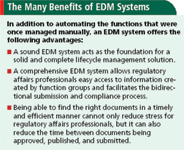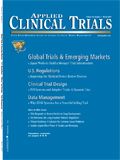Increase Your Company's Value with EDM
Why an electronic document management system is key to getting bought by major pharma.
When publishing a dossier, life science companies typically struggle with efficiently compiling supporting documentation. Usually this is the result of dealing with multiple formats and sources, including paper and electronic documents; legacy versions; and incomplete or inaccurate data due to human error. This does not need to be the case and cannot be the case if a startup biotech company is seeking to be bought by a major pharmaceutical company.

To prevent documentation from becoming a costly issue or impairing a biotech's ability to be purchased, companies can take steps on the front-end and throughout the entire document lifecycle to enable a smooth submission process and ultimately a smooth acquisition.
Invaluable data management
The business plan for startup biotech companies is clear: Bring your product to clinical trials as quickly as possible, capture and publish the results, and then implement your exit strategy to be bought. In this scenario, the only real property startup companies possess is their intellectual property. And companies are finding more and more that this research, especially given today's more stringent regulations, has a lot more value than originally thought.
Having research data in controlled electronic repositories can significantly increase a company's purchase value, since data is more up-to-date, readily accessible, and more comprehensive in the event of an audit. In this case, a potential buyer will be much more confident that the proper data has been captured and will not need to be concerned about missing content or surprises. Thus, a sound electronic compliant document management system becomes critical for a potential acquisition.
The bumpy road to EDM
Document management is nothing new to professionals in the life sciences industry. Long before the FDA and other regulatory bodies began developing their first guidance for format and content of eSubmissions, regulatory affairs professionals had to contend with the challenges of gathering and managing documents from disparate functional groups, including clinical, nonclinical, manufacturing, and drug safety. This information had to be organized to facilitate the bidirectional exchange of information between the applicants and regulatory agencies to meet guidelines such as those imposed on Investigational New Drug Applications (INDs) or New Drug Applications (NDAs).
For both the industry and regulators, the implementation of standards in electronic submission formatting was a welcomed relief from the previous ad hoc submission process, which had no standardized formats. Still, there remained a level of "disconnect" between the content and documents generated by the functional areas and what was eventually submitted to the regulatory bodies.

The Many Benefits of EDM Systems
From the time the investigational application is submitted until the time the marketing application is filed, there are often hundreds of documents filed. This makes it difficult for both the reviewer, who must at any given moment be sure of what the current and effective information is for the product, and the sponsor, who must manage the previous information that was submitted and the reasons for each update.
A lack of communication about critical updates, such as site enrollment information, changes in protocols, or submission of adverse events, can often lead to failure in compliance with agency guidelines. Failure to comply can lead to extended reporting periods, increased scrutiny from regulatory officials, and increased costs in bringing a product to market. Fortunately, the days of using spreadsheets to track which documents have been submitted for review and when amendments were filed for those documents are mercifully fading.
In companies around the globe, those labor-intensive spreadsheets are giving way to more advanced and heavily automated electronic technology called electronic document management (EDM) systems. Today's regulatory professionals rely on EDM systems—also referred to as content management systems (CMS)—to control the submission and compliance process. A good EDM system, properly configured, can easily track when documents need to be submitted, when different versions of a document are put up for submission, and what amendments have been made to existing files.
Today's EDM systems are not just for archiving and storing documents; an EDM system must bring management value for the content stored and automate many of the functions that have been managed manually. Following are examples of the features found in some of the better EDM systems offered on the market today and how they bring value to a regulatory professional and his or her company.
Real benefits for regulatory professionals
System notifications. This functionality, if used efficiently, can minimize communication "falling through the cracks" and reduce or even eliminate the number of failures to comply with reporting period regulations (study and investigator information, and adverse event reports).
An EDM system with notification functionality serves as an automatic communicator, sending an alert when documents are changed, under review or approved. This information can help a regulatory affairs professional plan and facilitate upcoming submissions by initiating communication with the functional areas preparing documents for submission.
System messaging. An EDM with properly set system messaging sends users messages regarding documents in the system that require a user's action. The level of detail and number of messages vary from system to system, but examples include the notification of a document change and the distribution of a document to a user of a workflow action required of the recipient (e.g., document editing, review or approval).
Versions. Most EDM systems allow for incremental document versioning as files are modified and brought back into the system. Version increments can vary, using minor versions (0.1, 0.2) and major versions (1.0, 2.0). According to generally accepted guidelines, major versions represent effective versions that have passed the approval stage and minor versions connote in-between drafts and reviewed versions.
Searches and audit trails. These required features are invaluable tools when RA professionals need to:
- Search for content that will either be used in a current submission or
- Find out what version of a document was used in a previous submission.
Lifecycle states. Lifecycle states are used as labels for versions of documents to indicate where they are in the document's lifecycle (Draft, Approved, Superceded, etc.). Some EDM systems permit configurable lifecycle states for documents, making it possible to assign lifecycle status such as "Submission Ready" to documents that have been approved for submission by a regulatory affairs professional or "Submitted" to indicate a document version that was submitted.
Lifecycle states provide more value to version numbers, as some EDM systems allow for multiple lifecycle states in the same version. This is important because if a functional area approves a document as version 1.0 Approved, regulatory affairs can circulate the same document as approved for use in a submission without changing the version number (1.0 Approved, Submission Ready). It would be misleading to have 1.0 Approved and 2.0 Submission Ready, as it would make it appear as if the document changed between the time it was approved by the functional area and when it was approved by regulatory affairs for use in a submission.
Permission models. Permission models enable documents to be seen by or hidden from users depending on their role or group. This is a particularly powerful tool if set permissions can be defined by lifecycle state, thus eliminating the accidental use of incorrect, superseded or unapproved versions of documents in submissions.
Document types/classes. Document types allow relevant information to be used to refer to documents. For example, when using an attribute to search for a clinical document, one may look for the study number or the clinical study component (protocol, CRF, Investigator CV) that classifies the document. Careful labeling of attributes and metadata is critical for searching as well as for organizing such documents. Similarly, document types can be used to label published output with information such as submission date, application type or submission category if they have been submitted to an agency.
Review period notification. Review period notifications can be applied for documents that require periodic review or submission. This will send a reminder message.
eSignature capabilities. eSignatures eliminate the time wasted on creating a paper document and then scanning it back into electronic form. In order to be 21 CFR Part 11 compliant, electronic signatures must include the name of the user, date and time of signature, and meaning of signature.
Attracting the best deal
These are just some examples of how an EDM system can play a vital role in automating, organizing, and reducing the complications inherent in the day-to-day tasks that must be performed by regulatory professionals. Selecting the right EDM system and combining it with a submission publishing tool that meets your business needs is critical to putting your startup company in the right light with potential suitors.
Many EDM systems on the market today, including hosted solutions, have existing integrations with multiple submission publishing tools. Knowing how to plan, manage, and control your content is the most important key to selecting a publishing tool. Understand your content management requirements first, then choose the EDM system that fits your needs and processes. Once you have your systems in place, you will be in a much better position to present your most up-to-date documentation quickly and easily. With intense competition out there among pharmaceutical companies, this cannot only make the difference between being bought but can help increase the deal by a significant amount.
Warren Perry is a compliance advisor for the Qumas Life Sciences division and is based in San Francisco, CA, email: wperry@qumas.com

FDA Fast Tracks Johnson & Johnson’s Nipocalimab for Fetal Neonatal Alloimmune Thrombocytopenia
March 27th 2024Johnson & Johnson is moving forward with a pair of Phase III trials of nipocalimab to reduce the risk of fetal neonatal alloimmune thrombocytopenia in alloimmunized pregnant patients.